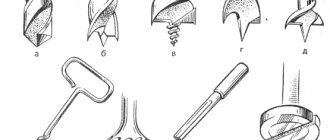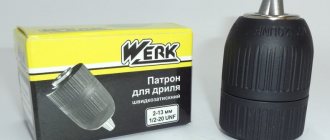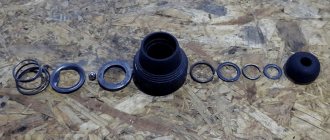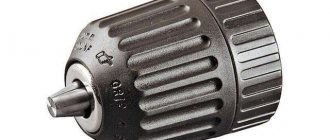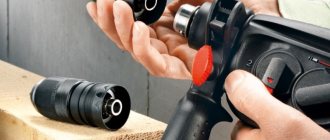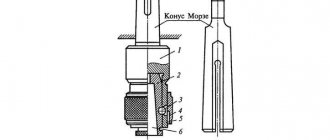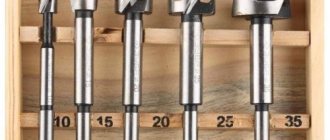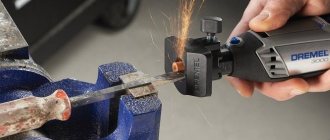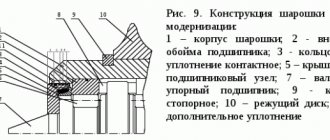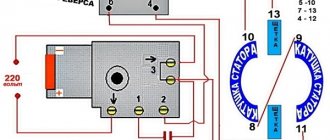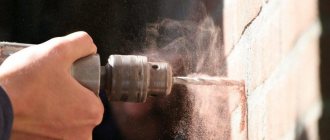Among home craftsmen, the most common types of drill chucks are key (gear-toothed) and quick-clamping (BZP). We will try to analyze the operating features of these particular cartridges in this article and comprehensively cover all the main nuances and difficulties of working with them.
The most common for household drills and screwdrivers are ring-gear and quick-release chucks
Drill chuck
The versatility of use is emphasized by the range of diameters and lengths of interchangeable nozzles. In this case, the processing of the material can be performed not only in the translational direction, continuing the body. In addition to the “classic” chucks with a clamping key, there is an angled chuck.
Angle chuck for drill
Unlike others, more common and described everywhere, it is almost unknown. Provides flexible work in the truest sense - right up to drilling around a corner or into the frame.
All types of chucks are divided into regular (key, quick-release, etc.) and special (flexible, extension, etc.). The whole difference is in versatility.
When it becomes necessary to choose a chuck for a drill, the types offered on the market will completely satisfy any master. Regardless of which drill and how often it will be used, you should pay attention to the simplicity of the chuck design.
Classic drill chuck
The cartridge is “classic”. The drill is fixed using a cam method - the replaceable nozzle is clamped from several sides. These cams (collets, petals) move under the influence of the compression screw and hold the shank of the nozzle.
Choice
Most portable drills have chucks screwed onto a threaded spindle that is connected to the drill and then held in place with a locking screw. To understand which element you need to buy to replace the old one, you need to open the petals to the widest point and look into the base with a flashlight. If you can see the screw at the bottom of the chuck, you should pay attention to the type of head. If it is missing, then it is probably a tapered spindle.
When purchasing, it is also worth considering that the element must provide the proper rigidity of the fastening, taking into account the number of revolutions. More expensive models reduce radial runout.
Last but not least is the ease of use of the chuck ; in this case, quick-release ones are in the first position, but when it comes to durability, it is better to buy one with a key.
If carbide drills are used, then the chuck must be self-centering, since such equipment has poor resistance to longitudinal bending. It is important to know that the rigidity of the fastening is always compared with the length of the nozzle and the material from which it is made.
How to remove a chuck from a drill
How to remove the chuck from a drill? This simple question baffles many craftsmen. There are several possible answers, depending on the design.
Threaded connection. The essence is the presence of a certain type of thread between the inside of the chuck and the drill shaft. Replacing the chuck on a drill is done as follows.
- The collet jaws should be set inward to the maximum level.
- When you have access to the locking screw, remove it. Rotation will most often be required clockwise - due to the left-hand thread.
- Fixing the shaft after removing the screw.
- Turning the cartridge out counterclockwise. To ensure that the cartridge can be unscrewed well, it is better to use a gas wrench. The most difficult thing is to move from the heaviest point.
Accordingly, you will need: a screwdriver, a gas wrench, a hammer and a vice. Installation is in reverse order. Experienced specialists note: you can turn on the drill or screwdriver in reverse at low speed. The tool will even help you repair yourself.
Connection via Morse cone. The shaft tip has the shape of a conical transition. All you need for removal is a hammer and a vice:
- The drill is installed in a vice with the chuck facing down.
- Use a hammer (or similar tool) to strike the cartridge lightly.
- When subjected to force, the cartridge seems to move from the landing site and is removed.
Other types are specific and are considered in exceptional cases.
As for the type of fastening of the replacement nozzle, it does not affect the type of installation of the cartridge itself.
Design features
The design of the cartridge is based on the use of a cam or collet mechanism in its design. Thanks to the element on the tool, you can easily clamp attachments of different shapes and diameters.
The cartridge consists of several parts:
- cylindrical body;
- sleeve rotating on the outside;
- 3 clamping tabs.
The last element plays a very important role in the design of the cartridge, so it is made of high-quality and high-strength steel. All petals are the same size and shape; when the sleeve rotates, they close, fixing the nozzle being used.
This mechanism is simply irreplaceable when using round drills, as it prevents them from turning inside the chuck.
There are several types of collet chucks with jaws inside:
- quick-release;
- key (gear-crown);
- mini-cartridges.
Quick-clamping ones are used without an additional key, which is their main advantage. The user has the opportunity to replace the cartridge quickly and without additional tools. Clamping is done automatically, which allows you to significantly reduce the time for changing attachments.
One of the disadvantages of the clamping chuck is instability during prolonged use. Over time, the mechanism becomes loose and can no longer provide the required level of fastening, as a result of which the round shanks rotate.
More experienced craftsmen prefer key chucks because they are more reliable and have to be tightened by hand. However, during operation it is easy to lose the key.
Mini-chucks that are installed on a small drill or drilling machine are no less in demand today. Most often, jewelers use small cartridges.
How to disassemble a drill chuck
How to disassemble a drill chuck? Everyone asks this question sooner or later.
There are 2 main methods for disassembling the cartridge - the key one (as the most used in household and professional appliances).
Perforator method:
- Diluting the collets before they go into the chuck.
- Install the insert into the cartridge.
- Support the drill with the insert against the shock absorber pad.
- Turn on the power tool for a couple of seconds - as a result, the “sleeve” (adjustment clutch) will be removed.
- The collets are removed - with the obligatory marking of their relative spatial position. The difficulty is that when assembling the collets, each one must take its place. Otherwise, centering the replacement tool will not be possible.
The need for a hammer drill lies in the fact that it is designed for forces that are greater than those of a drill.
Hammer disassembly method:
- Breeding collets.
- Install the chuck on the vice so that the body passes between the jaws, but the coupling does not.
- Warm up the coupling with a local heat source - a hair dryer is optimal.
- A plate is placed on the cartridge as a shock absorber.
- The housing from the adjusting coupling is knocked out with a hammer through the plate.
Drill chucks are quick-release. The order of their disassembly is as follows:
- The coupling is lifted and moved around the perimeter using a screwdriver.
- When the distance between it and the body becomes sufficient, you can remove it simply with your fingers.
- Extend your fists as far as possible.
- Insert the rod or bolt into the cartridge, and with calm blows of a hammer, the body is knocked out of the bottom of the coupling.
- Once these parts separate from each other, disassembly as a lubrication process stops. Further actions will lead to loss of structural integrity (assembly at this level is done under production conditions).
Cartridge mechanism problems
In modern drill models, such as Interskol or Makita, the drill or other attachments are secured by a chuck with a cam mechanism: 3 or 4 cams securely hold the cutting tool; they can only move along the axis of the drill shaft. The keyless chuck is adjusted manually; more complex designs used in modern drills are adjusted using a key.
During operation, a beating of the clamped bit may occur; the cause is wear of the cams during long-term operation. The tool is repaired as follows: you need to remove the device from the shaft; the same actions are necessary when the drill jams, because it can only be removed after completely disassembling the cartridge part of the product.
The following malfunction also occurs: the chuck rotates relative to the tool shaft. The reason for this behavior is damage to the threaded part of the device mount, or subsidence has occurred at the landing cone. The way out of this situation is to replace the cartridge with a working analogue.
Which way to unscrew the drill chuck?
Everyone probably remembers how to remove a cartridge from a Soviet drill. Modern electric models are not much different from the manual one.
The process of removing a chuck from an electric or hand tool begins with studying the documentation and markings. Any thread (regardless of the cutting side - left or right) is marked with an arrow and symbols.
Thread type - both metric and inch. Before applying physical force, you must ensure that the chosen direction is correct. There are frequent cases of normal breakdown and failure of this connection. Information is provided on the tool body and in the instructions.
The chuck rotates clockwise for drilling and tightening hardware. To ensure reliable fastening of the cartridge itself, the thread is usually made “left-handed”, left-handed. To unscrew it, you need to rotate it counterclockwise.
The thread size is indicated by letters. Type: M, metric, or UNF, inch. The numbers show diameter and pitch. The most commonly used thread is M14. It is very suitable for installing various adapters for the cartridge.
Which drill chuck is better?
The drill chuck plays the role of an adapter between the drill and the working tool. For any task or for each type of drill, you need to select the optimal chuck option. Working hours and workload are also important.
What is the most influential factor on the operation of a cartridge and what factors can cause it to fail? Replacing a cartridge in the field can be difficult if you don't have a spare.
- Quality of materials. The “Chinese” cartridge can fail during heavily loaded operations. Therefore, it is better to purchase high-quality models.
- If the drill or the chuck itself falls out, time is lost. When drilling at height, safety is at risk. In case of a loose conical fit with a loose fastening, measures must be taken in advance.
- Drill chuck runout. If this occurs, you should disassemble the drill chuck, check for contamination or adjust the fastenings. If bent, it usually cannot be repaired manually; it is best to replace it with a new one.
- Collets or jaws jamming. To rectify the situation, you will need to disassemble the cartridge (remove the cartridge itself if you know how and have already changed it). Cleaning, lubrication and assembly are carried out.
The most popular varieties besides the key one are: quick-clamping (or “bzp”) and self-clamping.
Cartridge mechanism problems
In modern drill models, such as Interskol or Makita, the drill or other attachments are secured by a chuck with a cam mechanism: 3 or 4 cams securely hold the cutting tool; they can only move along the axis of the drill shaft.
The keyless chuck is adjusted manually; more complex designs used in modern drills are adjusted using a key. During operation, a beating of the clamped bit may occur; the cause is wear of the cams during long-term operation. The tool is repaired as follows: you need to remove the device from the shaft; the same actions are necessary when the drill jams, because it can only be removed after completely disassembling the cartridge part of the product.
The following malfunction also occurs: the chuck rotates relative to the tool shaft. The reason for this behavior is damage to the threaded part of the device mount, or subsidence has occurred at the landing cone. The way out of this situation is to replace the cartridge with a working analogue.
Types of drill chucks
Any electric or hand drill has some kind of chuck for securing a replaceable tool. Depending on the type of installation on the drill itself, there are the following main types of cartridges:
- Threaded.
Installed by screwing onto the thread on the cartridge. Threads (type and diameter) are designated by casting and machining methods. Available for a certain range of working shank diameters.
- Conical (Morse cone).
It is installed by simply attaching it to a special cone-shaped element. It differs from the threaded one by the letter “B”. The best way to remove it is by knocking it down. Securing the replacement tool is most often done using the quick-clamping method.
Cone chuck for drill
Most often, the method is used in professional-grade power tools. The reason is the quality level of the cartridge fastening.
As for the methods of directly securing a replaceable tool, the types of cartridges according to this feature are given below.
Key
One of the most popular chucks for drills, mainly electric ones with low power.
Key cartridge
The main feature is the high reliability of fastening the replaceable tool. Replacement is performed with the tool turned off with both hands. In order to unscrew the attachment (drill or other, on the shank), a key is required.
It is a lever with a uniquely shaped part for interacting with the cartridge. Being fixed in the hole and receiving rotation, it displaces the lower part of the cartridge. In this case, the compression forces on the collets are removed, and the nozzle falls out. Everyone often forgets which way to turn the key: to unscrew it, you should turn it clockwise.
The scope of application has been expanded to impact drills. Thanks to the absence of drill rotation, the work process will not stop unexpectedly.
The interchangeability of keys contributes to the versatility of the power tool. A popular solution: attach this item with regular electrical tape to the power cord.
Quick-clamping
One of the most common types of drill chuck is the keyless chuck. Widely used for the production of electric drills and hammer drills.
Keyless chuck
Designed for the fastest possible replacement of interchangeable tools. Changing it is simple and does not require a key. You only need to hold the upper (end) part and unscrew it in the desired direction. Before work, it is recommended to study the instructions - there are models with left-hand threads.
There are chucks with 1 and 2 couplings. In a double-coupling one, you will have to hold the nozzle with both hands, so replacement may be inconvenient. An electric tool can, to some extent, be called a self-clamping chuck. In this case, the upper part with the nozzle is held with one hand. The second supplies power to the electric motor, which slowly rotates the shaft.
Collet chuck
The collet type of chuck is used for machines that process metal by cutting. The cutting tool is locked automatically. Limited use for mini drills.
Collet chuck
Main application: precision operations on lathes, drilling, milling machines. You can install both a cutting replacement attachment and a cylindrical workpiece to be processed. Due to the quick ability to change the chuck on a drill, it is optimal to use it on a drill or CNC machine.
The principle of operation is as follows. Design: collets (flat or volumetric clamping parts) and nut. As the collet nuts move, they compress, centering the inserted object and holding it in place. A cartridge with more collets works better. There are variations with three, four, six or more collets. Each of them is designed for a workpiece of a certain diameter.
Unscrewing such a tool is not difficult.
Mini chuck for drill
A mini drill chuck is also installed on a small drilling machine.
Mini chuck for drill
The main category of users are electronics engineers, jewelers and engravers, door and precision craftsmen. The main opportunity of this type of tool is to work with the diameter of the tail part of the cutting tool down to fractions of a millimeter.
The rotation frequency is almost unlimited, at the level of tens of thousands. Weight – up to tens of grams. Changing it is simple - the steps are similar to those performed for larger types.
Characteristics
A user who frequently uses a drill should know and understand the sizes of chucks that are on the market. In addition to the difference in shank diameter, some require the purchase of a separate adapter or adapter.
By the maximum diameter of the shank you can understand how widely the clamping blades diverge.
In this case it is:
The first sizes are rare, the others are much more common. Based on the power and size of the drill, the manufacturer selects the optimally accessible shank diameter. If this is a small tool, the power of which is only 300 W, there is no point in putting a 0.16 cm chuck on it. If the user cannot clamp the required attachment with the existing chuck because the sizes do not match, then it becomes necessary to choose another one with a larger diameter.
It is worth taking into account the minimum permissible value of the shank diameter, which can be 0.5, 0.8, 1, 1.5, 2, 3 millimeters. It is worth noting that the value of 0.5 mm is found on cartridges that have a maximum value of 6.5 mm, and so on in increasing order.
Another characteristic that you definitely pay attention to when choosing a suitable cartridge is the seat. It can be of two types: threaded and conical.
Modern manufacturers prefer to use the first option in the design of the tool; the second is used on those drills where the maximum shank diameter is 16 mm.
The threaded connection plays an equally important role. It could be:
The most popular sizes are 3*8 and 1*2. They are used on shank diameters of 0.10 and 0.13 cm.
There is only one type of metric thread - M12, it is used for cartridges with a shank diameter of 0.1, 0.13, 0.16 cm.
Among the characteristics of cartridges, you can also select a seat, which is designated as:
In this case, the numbers are the diameter, which is written in millimeters.
The honing head also plays an important role, the design of which depends on the length and diameter of the hole.
They are available for holes:
Last but not least is the shaft, which can be fixed or flexible. The first is located in the drill body, the second is screwed on, its design contains a flexible hose, it allows you to use the tool in hard-to-reach places.
